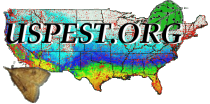

This risk index uses weather data to estimate fire blight infection risk for each day. Categories of low, moderate, and high risk are assigned to index values. These categories can be used to adjust application intervals of fungicides or other management actions such as fungicide selection and intensity of scouting.
This app is a newer, streamlined interface for the existing model, which is also available through MyPest Page.
Select the "Inputs" tab, search for weather stations near you, and choose one either from a list or a map. Be aware that some weather stations have poor quality or missing data. Our software estimates the quality of each station, but you may wish compare results for several nearby stations.
Optionally, you may choose a start date and a span (number) of days. If you leave the start date blank, the end of the output will be five days in the future, using forecast weather data, and the app will count back to a start date in the recent past.
You should also choose a local risk level, which describes the prevalence of fireblight in your vicinity.
Then, select "Graph" or "Table" to run the model. Your output will appear after 10-20 seconds depending on server load.
Fire blight infection can be predicted by measuring temperature following the occurrence of a wetting event, such as rain or dew, while the tree is in blossom and inoculative Erwinia amylovora bacteria are present. These bacterial colonies grow in warm temperatures (10-30°C / 50-86°F), increasing the risk of infections. This model (The Cougar Blight 2010 model by WSU) predicts the risk of infection based on two main factors:
Historical presence of fire blight in the location:
Hourly temperature data (which assumes nighttime dew is sufficient, as is generally the case in springtime) calculates a risk index value and a risk category using a lookup table (Smith, WSU, see link above):
Note that this model is only useful when blossoms are open. It is not intended for use, and has no predictive value, during high summer heat.
For a detailed description of the model, see the Cougar Blight 2010 page at WSU Extension. For general information about fire blight, see the fire blight page from the Pacific Northwest Disease Management Handbook.
Disclaimer: The index is intended to inform your decisions about management actions, such as choice and timing of control measures and intensity of scouting. It should supplement, not replace, the other factors you consider in making these decisions. Use at your own risk.
Automated email delivery of the disease risk index outputs displayed in this app is available at no cost. An email subscription offers model results for this and several other plant disease models, for up to three weather stations, on a schedule that you select. To subscribe, you will need a uspest.org account.
Next, use one of these buttons to run the model and see the output in the form of your choice.
To get this information by email, log in to or sign up for USPEST.org email notifications. To see the model output together with relevant weather inputs, go to MyPest Page.
To get this information by email, log in to or sign up for USPEST.org email notifications. To see the model output together with relevant weather inputs, go to MyPest Page.